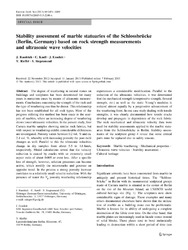Stability assessment of marble statuaries of the Schlossbrücke (Berlin, Germany) based on rock strength measurements and ultrasonic wave velocities
Ruedrich, J.
Knell, C.
Enseleit, J.
Rieffel, Y.
Siegesmund, S.
69, 4: 1451 - 1469
DOI: https://doi.org/10.1007/s12665-013-2246-x
Persistent URL: http://resolver.sub.uni-goettingen.de/purl?gldocs-11858/6943
Persistent URL: http://resolver.sub.uni-goettingen.de/purl?gldocs-11858/6943
Ruedrich, J.; Knell, C.; Enseleit, J.; Rieffel, Y.; Siegesmund, S., 2013: Stability assessment of marble statuaries of the Schlossbrücke (Berlin, Germany) based on rock strength measurements and ultrasonic wave velocities. In: Environmental Earth Sciences, Band 69, 4: 1451 - 1469, DOI: 10.1007/s12665-013-2246-x.
 |
Dokument öffnen: |
The degree of weathering in natural stones on buildings and sculptures has been determined for many years in numerous cases by means of ultrasonic measurements. Conclusions concerning the strength of the rock and the type of weathering can thus be drawn. This relationship has not been established for all rock types. Most of the progress utilizing this method has been made in the analysis of marbles, where an increasing degree of weathering shows lower ultrasonic velocities. In the present study, four Carrara marble samples showing similar rock fabrics, but with respect to weathering exhibit considerable differences are investigated. Porosity varies between 0.2 vol. % and ca. 2.4 vol. %, whereby with increasing porosity the pore radii changes as well. Parallel to this the ultrasonic velocities change in dry samples from about 5.5 to 1.6 km/s, respectively. Model calculations reveal that the velocity reduction is caused by cracks with an extremely small aspect ratio of about 0.005 or even less. After a specific loss of strength, however, solution processes can become active, which modify the microcracks and generate an opposite trend. In the process a strong porosity increase correlates to a relatively small velocity reduction. With the presence of water the Vp porosity weathering relationship experiences a considerable modification. Parallel to the reduction of the ultrasonic velocities, it was determined that the mechanical strength (compressive strength, flexural strength, etc.) as well as the static Young’s modulus is reduced almost equally by a progressive advancement of the weathering front. In one case study dealing with tensile strengths, it was clearly documented how tensile cracks develop and propagate in dependence of the rock fabric. The rock mechanical and ultrasonic velocity data were used for stability assessments applied to the marble statuaries from the Schlossbrücke in Berlin. Stability assessments of the sculpture group 4 reveal that some critical parts must be replaced due to safety reasons.
Statistik:
ZugriffsstatistikSammlung:
- Geologie [933]

